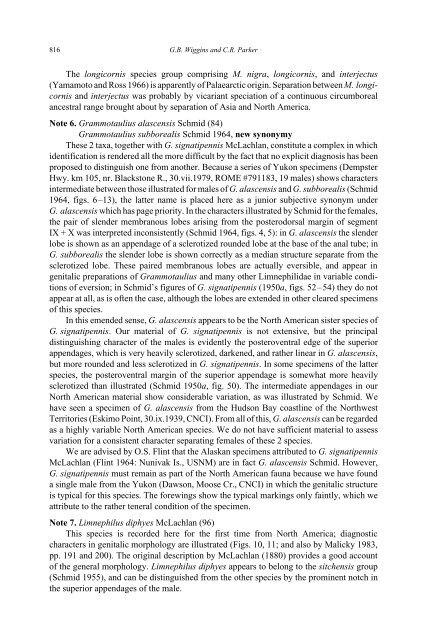Caddisflies of the Yukon - Department of Biological Sciences ...
Caddisflies of the Yukon - Department of Biological Sciences ...
Caddisflies of the Yukon - Department of Biological Sciences ...
Create successful ePaper yourself
Turn your PDF publications into a flip-book with our unique Google optimized e-Paper software.
816 G.B. Wiggins and C.R. Parker<br />
The longicornis species group comprising M. nigra, longicornis, and interjectus<br />
(Yamamoto and Ross 1966) is apparently <strong>of</strong> Palaearctic origin. Separation between M. longicornis<br />
and interjectus was probably by vicariant speciation <strong>of</strong> a continuous circumboreal<br />
ancestral range brought about by separation <strong>of</strong> Asia and North America.<br />
Note 6. Grammotaulius alascensis Schmid (84)<br />
Grammotaulius subborealis Schmid 1964, new synonymy<br />
These 2 taxa, toge<strong>the</strong>r with G. signatipennis McLachlan, constitute a complex in which<br />
identification is rendered all <strong>the</strong> more difficult by <strong>the</strong> fact that no explicit diagnosis has been<br />
proposed to distinguish one from ano<strong>the</strong>r. Because a series <strong>of</strong> <strong>Yukon</strong> specimens (Dempster<br />
Hwy. km 105, nr. Blackstone R., 30.vii.1979, ROME #791183, 19 males) shows characters<br />
intermediate between those illustrated for males <strong>of</strong> G. alascensis and G. subborealis (Schmid<br />
1964, figs. 6 –13), <strong>the</strong> latter name is placed here as a junior subjective synonym under<br />
G. alascensis which has page priority. In <strong>the</strong> characters illustrated by Schmid for <strong>the</strong> females,<br />
<strong>the</strong> pair <strong>of</strong> slender membranous lobes arising from <strong>the</strong> posterodorsal margin <strong>of</strong> segment<br />
IX + X was interpreted inconsistently (Schmid 1964, figs. 4, 5): in G. alascensis <strong>the</strong> slender<br />
lobe is shown as an appendage <strong>of</strong> a sclerotized rounded lobe at <strong>the</strong> base <strong>of</strong> <strong>the</strong> anal tube; in<br />
G. subborealis <strong>the</strong> slender lobe is shown correctly as a median structure separate from <strong>the</strong><br />
sclerotized lobe. These paired membranous lobes are actually eversible, and appear in<br />
genitalic preparations <strong>of</strong> Grammotaulius and many o<strong>the</strong>r Limnephilidae in variable conditions<br />
<strong>of</strong> eversion; in Schmid’s figures <strong>of</strong> G. signatipennis (1950a, figs. 52 – 54) <strong>the</strong>y do not<br />
appear at all, as is <strong>of</strong>ten <strong>the</strong> case, although <strong>the</strong> lobes are extended in o<strong>the</strong>r cleared specimens<br />
<strong>of</strong> this species.<br />
In this emended sense, G. alascensis appears to be <strong>the</strong> North American sister species <strong>of</strong><br />
G. signatipennis. Our material <strong>of</strong> G. signatipennis is not extensive, but <strong>the</strong> principal<br />
distinguishing character <strong>of</strong> <strong>the</strong> males is evidently <strong>the</strong> posteroventral edge <strong>of</strong> <strong>the</strong> superior<br />
appendages, which is very heavily sclerotized, darkened, and ra<strong>the</strong>r linear in G. alascensis,<br />
but more rounded and less sclerotized in G. signatipennis. In some specimens <strong>of</strong> <strong>the</strong> latter<br />
species, <strong>the</strong> posteroventral margin <strong>of</strong> <strong>the</strong> superior appendage is somewhat more heavily<br />
sclerotized than illustrated (Schmid 1950a, fig. 50). The intermediate appendages in our<br />
North American material show considerable variation, as was illustrated by Schmid. We<br />
have seen a specimen <strong>of</strong> G. alascensis from <strong>the</strong> Hudson Bay coastline <strong>of</strong> <strong>the</strong> Northwest<br />
Territories (Eskimo Point, 30.ix.1939, CNCI). From all <strong>of</strong> this, G. alascensis can be regarded<br />
as a highly variable North American species. We do not have sufficient material to assess<br />
variation for a consistent character separating females <strong>of</strong> <strong>the</strong>se 2 species.<br />
We are advised by O.S. Flint that <strong>the</strong> Alaskan specimens attributed to G. signatipennis<br />
McLachlan (Flint 1964: Nunivak Is., USNM) are in fact G. alascensis Schmid. However,<br />
G. signatipennis must remain as part <strong>of</strong> <strong>the</strong> North American fauna because we have found<br />
a single male from <strong>the</strong> <strong>Yukon</strong> (Dawson, Moose Cr., CNCI) in which <strong>the</strong> genitalic structure<br />
is typical for this species. The forewings show <strong>the</strong> typical markings only faintly, which we<br />
attribute to <strong>the</strong> ra<strong>the</strong>r teneral condition <strong>of</strong> <strong>the</strong> specimen.<br />
Note 7. Limnephilus diphyes McLachlan (96)<br />
This species is recorded here for <strong>the</strong> first time from North America; diagnostic<br />
characters in genitalic morphology are illustrated (Figs. 10, 11; and also by Malicky 1983,<br />
pp. 191 and 200). The original description by McLachlan (1880) provides a good account<br />
<strong>of</strong> <strong>the</strong> general morphology. Limnephilus diphyes appears to belong to <strong>the</strong> sitchensis group<br />
(Schmid 1955), and can be distinguished from <strong>the</strong> o<strong>the</strong>r species by <strong>the</strong> prominent notch in<br />
<strong>the</strong> superior appendages <strong>of</strong> <strong>the</strong> male.
















